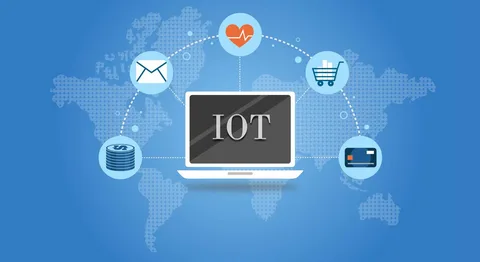
The Internet of Things (IoT) is changing the way mobile apps interact with the world. Integrating IoT with mobile applications provides businesses with enhanced functionality, new opportunities, and more personalized user experiences. But how exactly can you use IoT in mobile app development? In this article, we’ll dive into the practicalities, advantages, and challenges of incorporating IoT technology into your mobile apps.
IoT in Mobile App Development
The Internet of Things (IoT) connects everyday devices to the internet, allowing them to collect and exchange data. For top mobile app developers, integrating IoT into apps opens up endless possibilities for creating dynamic, interactive, and automated systems. With IoT, mobile apps can interact with a wide array of devices, such as smart appliances, wearable devices, or even industrial machines, in real time.
As IoT continues to grow, mobile app developers must understand how to leverage it for creating intuitive, useful, and high-performing apps. Whether you’re developing a new app or enhancing an existing one, IoT technology can give your app a competitive edge in the market.
Why IoT is Important for Mobile App Development
IoT is changing the mobile app development landscape by introducing interactivity beyond the screen. It enables mobile apps to communicate directly with external devices, thus creating seamless user experiences. With IoT integration, mobile apps can manage and control smart devices, provide instant notifications, and even automate processes in real time.
For businesses, incorporating IoT into their mobile apps can increase engagement, streamline operations, and provide deeper insights into user behavior.
How IoT Works in Mobile Apps
Understanding the underlying mechanisms of IoT technology in mobile apps is crucial for developers. At a high level, the process involves connecting IoT-enabled devices to the mobile app through a combination of communication protocols and cloud integration.
Communication Protocols
Communication protocols are the rules and standards that govern how devices communicate with each other. Some common IoT communication protocols used in mobile apps include:
-
Wi-Fi: Ideal for high-bandwidth tasks, like streaming data.
-
Bluetooth: Useful for short-range communication with low energy consumption, commonly used in wearable devices.
-
Zigbee/Z-Wave: Low-power protocols used in home automation and other IoT applications.
-
NFC: Used for very short-range communication, such as in mobile payments.
Each protocol serves different purposes, and choosing the right one depends on the app’s specific needs and the devices it interacts with.
Cloud Integration
Most IoT systems rely on cloud platforms to store and process data from IoT devices. The cloud allows mobile apps to access real-time data, store historical data, and run complex analytics. Popular cloud platforms for IoT include Google Cloud, Amazon Web Services (AWS), and Microsoft Azure.
By integrating your mobile app with these platforms, you can ensure data security, scalability, and smooth device management, which are essential for any IoT-powered app.
Benefits of Integrating IoT with Mobile Apps
The integration of IoT with mobile apps brings a plethora of advantages to both developers and end-users. Let’s break down some of the key benefits.
Enhanced User Experience
IoT-enabled mobile apps offer a richer user experience by allowing users to interact with their physical environment through their mobile devices. For instance, users can control their home’s lighting or temperature from anywhere via their mobile app, making it more intuitive and convenient.
Increased Efficiency and Automation
IoT allows apps to automate many functions, such as adjusting settings on devices, sending reminders, or alerting users about device malfunctions. This automation saves time and boosts efficiency, especially in sectors like manufacturing, logistics, and healthcare.
Real-Time Data Access
With IoT, mobile apps can access real-time data from connected devices, allowing users to make faster, data-driven decisions. For example, fitness apps can track heart rate or calorie consumption instantly, while inventory management apps can update stock levels in real time.
Cost Efficiency
IoT-enabled mobile apps can help businesses save costs by optimizing operations and reducing human intervention. For example, predictive maintenance in industrial IoT can reduce downtime, and smart energy management systems can cut energy consumption.
Challenges of Implementing IoT in Mobile App Development
While the potential benefits are vast, integrating IoT with mobile apps is not without its challenges. Let’s take a look at some of the most common issues developers face.
Security and Privacy Concerns
Since IoT devices collect and transmit sensitive data, ensuring the security of this data is crucial. Mobile apps must implement robust encryption, secure communication protocols, and regular updates to protect user privacy and data integrity.
Scalability and Performance Issues
As the number of connected devices grows, mobile apps must be able to handle large volumes of data without compromising performance. Developers must ensure that the app is scalable and can handle both high traffic and numerous connected devices seamlessly.
Device Compatibility
With so many different IoT devices on the market, ensuring compatibility between the app and all possible devices can be a significant challenge. Developers must conduct thorough testing to ensure that the app works properly with a wide range of IoT devices.
Steps to Integrate IoT in Mobile App Development
Building a mobile app with IoT integration requires careful planning and execution. Here’s a step-by-step guide to help you through the process.
Define Your IoT Objectives
Before you start development, clarify what you want to achieve with IoT integration. Do you want to control smart home devices, track health metrics, or manage industrial machinery? Defining clear objectives will guide the entire development process.
Choose the Right Communication Protocol
Select the communication protocols that best suit your app’s requirements. If you’re working with wearables, Bluetooth might be your go-to option. For smart homes, Wi-Fi or Zigbee could work best. Make sure your protocol is suitable for the app’s range, speed, and data requirements.
Select a Reliable IoT Platform
Choose an IoT platform that suits your app’s needs. Platforms like AWS IoT, Google Cloud IoT, or Microsoft Azure provide comprehensive services for device management, data storage, and analytics.
Develop the App with IoT Features
With your objectives, protocols, and platform in place, you can begin building the app. Focus on integrating IoT functionality, ensuring it is easy for users to connect and control devices. Don’t forget about UX/UI design, as the app must be intuitive and responsive.
Test and Iterate
Testing is vital when it comes to IoT apps. Test how the app interacts with different devices and check for bugs, connectivity issues, and performance bottlenecks. Continuously iterate based on user feedback to improve the app.
Popular IoT Use Cases in Mobile Apps
Several industries are benefiting from IoT integration into mobile apps. Here are some popular use cases.
Smart Home Automation
IoT technology enables mobile apps to control devices like thermostats, security cameras, and lights. Users can adjust settings remotely, set schedules, or receive alerts when something goes wrong.
Healthcare and Fitness Apps
Fitness trackers and healthcare monitoring devices can send data to mobile apps, allowing users to track health metrics like heart rate, blood pressure, and sleep patterns. This data helps users stay informed about their health in real-time.
Agriculture and Environmental Monitoring
IoT devices can monitor soil moisture, weather conditions, and crop health, providing valuable insights for farmers. Apps can collect this data and help farmers optimize irrigation, fertilization, and pest control practices.
Smart Cities and Infrastructure
IoT integration helps cities monitor traffic, manage energy consumption, and improve waste management. Mobile apps provide real-time data that helps authorities make better decisions and keep residents informed.
The Role of Mobile App Development Companies in IoT Integration
A professional mobile app development company in USA like Devherds plays a key role in ensuring successful IoT integration. With the right expertise, these companies can handle everything from IoT device management to backend cloud services and user-friendly mobile interfaces. Choosing an experienced team of mobile app developers in USA will ensure the smooth deployment of your IoT-powered app.
How Devherds Can Help You Integrate IoT in Your Mobile App
At Devherds, we specialize in mobile app development services in the USA, including IoT integration. Whether you’re looking to build a smart home app, a health tracking app, or a connected car app, our team of experts can help bring your vision to life. We offer Mobile App Development Solutions in USA that are secure, scalable, and optimized for performance.
Conclusion
Integrating IoT with mobile apps opens up endless possibilities for enhancing user experience, improving efficiency, and creating innovative solutions across multiple industries. While there are challenges to overcome such as security, scalability, and device compatibility the benefits far outweigh the obstacles.
With the right expertise from a leading mobile application development company in USA like Devherds, you can take full advantage of IoT technology to create truly transformative mobile applications.
FAQs
1. What is IoT technology in mobile apps?
IoT technology in mobile apps refers to the integration of connected devices, allowing the app to interact with and control physical devices like smart home gadgets, wearables, or industrial machinery.
2. Why should I use IoT in my mobile app?
Integrating IoT enables real-time data collection, automation, and enhanced user experiences, allowing your app to connect seamlessly with external devices.
3. What are the most common IoT communication protocols?
The most common IoT communication protocols include Wi-Fi, Bluetooth, Zigbee, Z-Wave, and NFC, each suited to different use cases based on range, power, and data needs.
4. How can Devherds help me with IoT integration?
Devherds offers mobile app development services in USA, providing expertise in IoT integration. Our team can help you choose the right communication protocol, develop the app, and ensure secure, scalable solutions.
5. What are some popular IoT app use cases?
Popular IoT app use cases include smart home automation, healthcare monitoring, agriculture, and smart city applications, all benefiting from the ability to collect and analyze real-time data.




